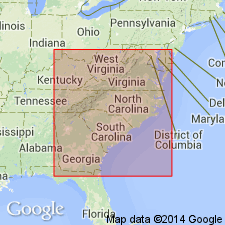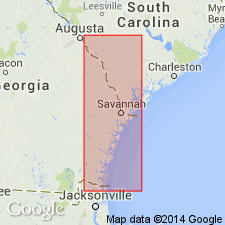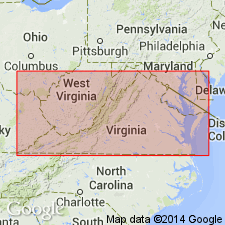
- Usage in publication:
-
- Morgarts Beach Member*
- Modifications:
-
- Named
- Dominant lithology:
-
- Clay
- Sand
- AAPG geologic province:
-
- Atlantic Coast basin
Summary:
Named as member of Yorktown Formation. Named for Morgarts Beach, Mulberry Island 7.5-min quad, Isle of Wight Co., eastern VA. Occurs in eastern VA (including southern end of Delmarva Peninsula) and northeastern NC. Consists of gray, very fine, sandy to silty clay with a few silty, very fine sand beds. Thickness is as much as 6 m. Conformably overlies Rushmere Member (new); members grade into each other in places. Contact is marked by change in lithology. Conformably underlies Moore House Member (new); member grade into each other in places. Report contains generalized geologic map, correlation chart, and fossil list. Shares same molluscan assemblage with Rushmere and Moore House Members, but not in as much abundance as in sandier Rushmere; fossils too numerous to list here. Age is late Pliocene.
Source: GNU records (USGS DDS-6; Reston GNULEX).

- Usage in publication:
-
- Morgarts Beach Member
- Modifications:
-
- Areal extent
- Overview
- AAPG geologic province:
-
- Atlantic Coast basin
Summary:
"Rushmere and Morgarts Beach Members of the Yorktown represent the transgressive and regressive stages of the most extensive transgression in the Pliocene and Pleistocene series." In southeastern VA, the Morgarts Beach was probably deposited in broad sounds or lagoons behind barrier bars or shoals. In the east-central part of the Albemarle embayment and in downdip areas, unit is very shelly, silty sand. Contact with the underlying Rushmere Member is gradational. South of the Neuse River the Rushmere and Morgarts Beach are indistinguishable and coeval strata is known as the Duplin Formation. Age is late Pliocene.
Source: GNU records (USGS DDS-6; Reston GNULEX).

- Usage in publication:
-
- Morgarts Beach Member*
- Modifications:
-
- Biostratigraphic dating
- Overview
- AAPG geologic province:
-
- Atlantic Coast basin
Summary:
Figure 6 shows these equivalent relationships: Duplin Formation used in southeastern NC and northeastern SC and assigned late early and late Pliocene age. Raysor Formation used in southeastern SC and all of GA and assigned late Pliocene age. Jackson Bluff Formation, and Rushmere and Morgarts Beach Members of Yorktown Formation are assigned late Pliocene age. In southeastern GA, fossils consistent with Zone PL3 of Berggren (1973) are equivalent wholly or in part to Duplin and Raysor Formations, to Rushmere Member of upper part of Yorktown Formation in southeastern VA and northeastern NC (numerous references and L.W. Ward, Virginia Museum of Natural History, 1990, written commun.), and to Jackson Bluff Formation of extreme northern FL.
Source: GNU records (USGS DDS-6; Reston GNULEX).

- Usage in publication:
-
- Morgarts Beach Member
- Modifications:
-
- Revised
- AAPG geologic province:
-
- Atlantic Coast basin
Summary:
Author states that the single Yorktown transgressive-regressive cycle model endorsed by many works, including Campbell and others (1975) and Ward and Blackwelder (1980) is now untenable. Consequently, the members proposed by Ward and Blackwelder based on that model are in need of revision. The Rushmere, Morgarts Beach, and Moore House Members are not lithostratigraphic units. Their characteristic sediment types recur frequently through the Yorktown section. They are non-coherent when examined against the Krantz (1991) oxygen isotope model. They are mappable only if restricted to the definitions of their stratotype sections. Only the Sunken Meadow is unchanged in this report. According to the author, the Morgarts Beach is a valid lithologic member only when applied to the K-10 (of Krantz, 1991) silts and clays which accumulated west of the Chuckatuck topographic high. The bar cross-beds at Chuckatuck should not be mapped as part of the Morgarts Beach, nor should other bar-and-sound deposits. [It is mentioned in a footnote of this report, that the spelling on the topographic map is "Mogarts" Beach, but author follows tradition in using two r's for "Morgarts."]
Source: GNU records (USGS DDS-6; Reston GNULEX).
For more information, please contact Nancy Stamm, Geologic Names Committee Secretary.
Asterisk (*) indicates published by U.S. Geological Survey authors.
"No current usage" (†) implies that a name has been abandoned or has fallen into disuse. Former usage and, if known, replacement name given in parentheses ( ).
Slash (/) indicates name conflicts with nomenclatural guidelines (CSN, 1933; ACSN, 1961, 1970; NACSN, 1983, 2005, 2021). May be explained within brackets ([ ]).

